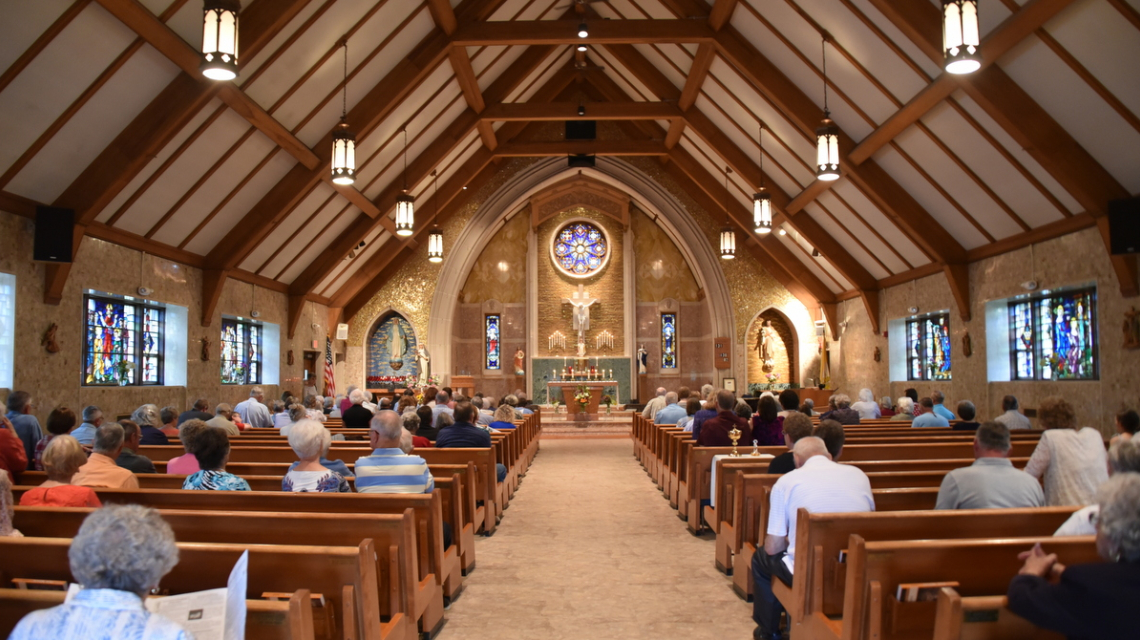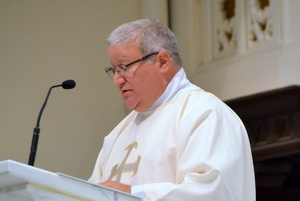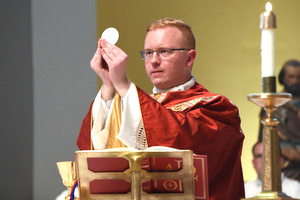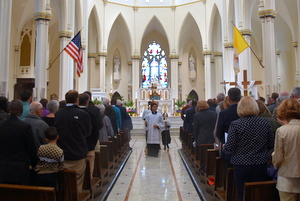Understanding the Mass

The Introductory Rite
The Mass begins with the entrance chant/song. The celebrant and other ministers enter in procession and reverence the altar with a bow and/or a kiss. The altar is a symbol of Christ at the heart of the assembly and so deserves this special reverence.
All make the Sign of the Cross and the celebrant extends a greeting to the gathered people in words taken from Scripture.
The Penitential Act follows the greeting. At the very beginning of the Mass, the faithful recall their sins and place their trust in God's abiding mercy. The Penitential Act includes the Kyrie Eleison, a Greek phrase meaning, "Lord, have mercy." This litany recalls God's merciful actions throughout history. On Sundays, especially in Easter Time, in place of the customary Penitential Act, from time to time the blessing and sprinkling of water to recall Baptism may take place.
On Sundays, solemnities, and feasts, the Gloria follows the Penitential Act. The Gloria begins by echoing the proclamation of the angels at the birth of Christ: "Glory to God in the highest!" In this ancient hymn, the gathered assembly joins the heavenly choirs in offering praise and adoration to the Father and Jesus through the Holy Spirit.
The Introductory Rites conclude with an opening prayer, called the Collect. The celebrant invites the gathered assembly to pray and, after a brief silence, proclaims the prayer of the day. The Collect gathers the prayers of all into one and disposes all to hear the Word of God in the context of the celebration.
The Liturgy of the Word

In the Liturgy of the Word, the Church feeds the people of God from the table of his Word (cf. Sacrosanctum Concilium, no. 51). The Scriptures are the word of God, written under the inspiration of the Holy Spirit. In the Scriptures, God speaks to us, leading us along the path to salvation.
The Responsorial Psalm is sung between the readings. The psalm helps us to meditate on the word of God.
The high point of the Liturgy of the Word is the reading of the Gospel. Because the Gospels tell of the life, ministry, and preaching of Christ, it receives several special signs of honor and reverence. The gathered assembly stands to hear the Gospel and it is introduced by an acclamation of praise. Apart from Lent, that acclamation is "Alleluia," derived from a Hebrew phrase meaning "Praise the Lord!" A deacon (or, if no deacon is present, a priest) reads the Gospel.
After the Scripture readings, the celebrant preaches the homily. In the homily, the preacher focuses on the Scripture texts or some other texts from the liturgy, drawing from them lessons that may help us to live better lives, more faithful to Christ's call to grow in holiness.
In many Masses, the Profession of Faith then follows the homily, either the Nicene or Apostles' Creed. The Nicene Creed is a statement of faith dating from the fourth century, while the Apostles' Creed is the ancient baptismal creed of the Church in Rome. If baptismal promises are renewed, from a formula based on the Apostles' Creed, this takes the place of the Creed.
The Liturgy of the Word concludes with the Universal Prayer, also called the Prayer of the Faithful. The gathered assembly intercedes with God on behalf of the Church, the world, and themselves, entrusting their needs to the faithful and loving God.
The Liturgy of the Eucharist
The Liturgy of the Eucharist begins with the preparation of the gifts and the altar. As the ministers prepare the altar, representatives of the people bring forward the bread and wine that will become the Body and Blood of Christ. The celebrant blesses and praises God for these gifts and places them on the altar, the place of the Eucharistic sacrifice. In addition to the bread and wine, monetary gifts for the support of the Church and the care of the poor may be brought forward. The Prayer over the Offerings concludes this preparation and disposes all for the Eucharistic Prayer.
The Eucharistic Prayer

The introductory dialogue, establishes that this prayer is the prayer of the baptized and ordained, is offered in the presence of God, and has thanksgiving as its central focus. Following this dialogue, the celebrant begins the Preface.
The Eucharistic Prayers make clear that these prayers are offered not to Christ, but to the Father. It is worship offered to the Father by Christ as it was at the moment of his Passion, death and resurrection, but now it is offered through the priest acting in the person of Christ, and it is offered as well by all of the baptized, who are part of Christ's Body, the Church. This is the action of Christ's Body, the Church at Mass.
The priest offers the Eucharistic Prayer in the first person plural, for example, "Therefore, O Lord, we humbly implore you…" This "we" signifies that all the baptized present at the Eucharistic celebration make the sacrificial offering in union with Christ, and pray the Eucharistic Prayer in union with him. And what is most important, we do not offer Christ alone; we are called to offer ourselves, our lives, our individual efforts to grow more like Christ and our efforts as a community of believers to spread God's Word and to serve God's people, to the Father in union with Christ through the hands of the priest. Most wonderful of all, although our offering is in itself imperfect, joined with the offering of Christ it becomes perfect praise and thanksgiving to the Father.
[Read more about the elements of the Eucharistic Prayer]
The Communion Rite
.JPG)
The Rite of Peace follows. The celebrant prays that the peace of Christ will fill our hearts, our families, our Church, our communities, and our world. As a sign of hope, the people extend to those around them a sign of peace.
In the Fraction Rite, the celebrant breaks the consecrated bread as the people sing the Agnus Dei or "Lamb of God." John the Baptist proclaimed Jesus as "the Lamb of God who takes away the sin of the world" (Jn 1:29). The action of breaking the bread recalls the actions of Jesus at the Last Supper, when he broke the bread before giving it to his disciples. One of the earliest names for the Eucharistic celebration is the breaking of the bread (Lk 24:35; Acts 2:42, 46).
Before receiving Holy Communion, the celebrant and assembly acknowledge their unworthiness to receive so great a gift. The celebrant receives Holy Communion first and then the people come forward.
Those who receive Holy Communion should be prepared to receive so great a gift. They should fast (except for medicines) for at least one hour before receiving the Eucharist and should not be conscious of having committed serious sin.
Because sharing at the Eucharistic Table is a sign of unity in the Body of Christ, only those in communion with the Catholic Church may receive Holy Communion. To invite others present to receive Holy Communion implies a unity which does not exist. Those who do not receive Holy Communion still participate in this rite by praying for unity with Christ and with each other.
The people approach the altar and, bowing with reverence, receive Holy Communion. People may receive the Body of Christ either on the tongue or in the hand. The priest or other minister offers the Eucharist to each person saying, "The Body of Christ." The person receiving responds by saying, "Amen," a Hebrew word meaning, "So be it" (Catechism of the Catholic Church, 2856).
As the people receive Holy Communion, the communion chant/song is sung. The unity of voices echoes the unity the Eucharist brings. All may spend some time in silent prayer of thanksgiving as well.
The Communion Rite ends with the Prayer after Communion which asks that the benefits of the Eucharist will remain active in our daily lives.
Concluding Rites

After the blessing, the deacon dismisses the people. In fact, the dismissal gives the liturgy its name. The word "Mass" comes from the Latin word, " Missa." At one time, the people were dismissed with the words "Ite, missa est" (literally meaning "Go, she—meaning you, the Church—has been sent"). The word "Missa" is related to the word "missio," the root of the English word "mission." The liturgy does not simply come to an end. Those assembled are sent forth to bring the fruits of the Eucharist to the world.
(Information courtesy of the USCCB)
Understanding the Mass (Video links)
- Introduction
- The Introductory Rites
- The Liturgy of the Word
- The Homily, Creed, and General Intercessions
- The Preparation of the Gifts
- Eucharistic Prayer and Holy Communion
- The Concluding Rites









